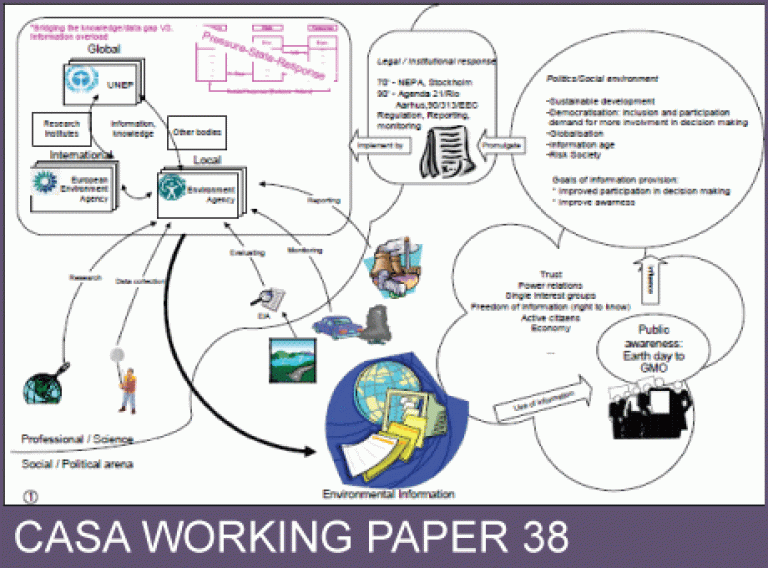CASA Working Paper 38

1 October 2001
Conceptual Models of Urban Environmental Information Systems - Toward Improved Information Provision.
Cities are the hub of European society - for over a millennium, they are the locus of social, political and economic development. As the core of intensive and creative human activity, they are also the place where the environmental externalities that accompany rapid development are most visible. The environmental consequences of urban development have been recognised long ago, as in the case of London, where in 1388 legislation was introduced to control pollutant emissions (Lowenthal, 1990).
Similar historical environmental regulations can be demonstrated for many cities in Europe. However, while for most of history those who govern the city (be it the sovereign, city elders or local government) where responsible for the control, mitigation and management of the common environment in the city, the last 30 years are a period of profound change. This is due to the trend toward improved participation in environmental decision making a more inclusive and open approach to decisions that deal with the city commons. This change did not occurre overnight but rather gradually. For example, in the United Kingdom, it was the Town and Country Planning Act of 1947 which introduced public scrutiny to changes in the urban form (Rydin, 1998), or the development of public involvement in environmental impact assessment of urban projects as developed in many countries throughout the developed world during the 1970s and 1980s (Gilpin 1995). These changes accelerate within the last three decades, and especially since the publication of "Our Common Future" (WCED and Brundtland 1987), the acceptance of the "Sustainable Development" principles and the Rio conference. A quiet (mini) revolution happened in Europe not long ago, toward the end of 1998 when the members of the United Nations Economic Commission for Europe (UN/ECE) signed the "Convention on Access to Information, Public Participation in Decision Making and Access to Justice in Environmental Matters" - the Aarhus Convention (UN/ECE 1998). The convention is expected to come into force by the end of 2001, and calls the governments and public authorities to open up access to environmental information as a means to improve public participation in environmental decision making and awareness of environmental issues (UN/ECE, 1998).
However, these declarations on the value and importance of environmental information do not match our level of understanding on the role of environmental information in decision making processes, and especially on the role of information in improving awareness and participation. Therefore, it is useful to take a step back, and to try and evaluate how environmental information and access to it and its use support public involvement in such processes.
This paper is aimed to offer a framework that can assist us in the analytical process of understanding environmental information use. It focuses on public access and assumes that environmental information will be delivered to the public through the Internet. Such assumption is based on the current trend within public authorities is to use Information and Communication Technology (ICT) as a major delivery medium and it seems that it will become more so in the near future (OECD 2000).
The framework which this paper presents, is based on Soft Systems Methodology (SSM) study which unpacked some of the core issues relating to public access and use of environmental information (Haklay, 2001). Although the aim here is not to discuss the merits of SSM, but to focus on the conceptual models, some introduction to the techniques that are used here is needed. Therefore, the following section opens with introduction to SSM and its techniques. The core of the paper is dedicated to the development of conceptual models. After presenting the conceptual models, some conclusions about these models and their applications are drown.
This working paper is available as a PDF. The file size is 1.44MB.
Authors: Muki Haklay
Publication Date: 1/9/2001
 Close
Close

